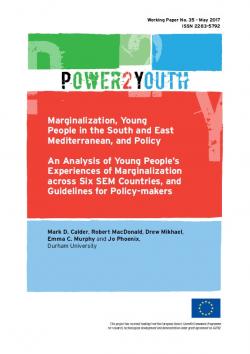Marginalization, Young People in the South and East Mediterranean, and Policy. An Analysis of Young People's Experiences of Marginalization across Six SEM Countries, and Guidelines for Policy-makers
This document is the report for Work Package 7 (WP7) of the EU-funded project Power2Youth (P2Y). WP7 provides an overview of the key policy messages for the EU that arise from the research conducted as part of Work Packages 1–6. These key messages are: (1) Young people face multiple forms of marginalization, with the exact nature and combination depending on their social circumstances (including but not exclusively nationality, place of residence, socio-economic class, religion, sect, gender and clan); (2) The problems faced by young people in the South and East Mediterranean (SEM) countries are reminiscent of those faced by young people in the EU; however, they are often faced in more extreme form (e.g., rates of graduate unemployment) and some are quite different (e.g., the extreme levels of political and personal insecurity endured by SEM young people); (3) Although young people are particularly vulnerable to processes of marginalization, these processes are not exclusive to them and are indicative of deeper structural problems (political and economic) affecting populations as a whole; (4) The processes that do most to marginalize young people (and people more generally) are not currently addressed by national policies; in fact, national policies can exacerbate young people’s problems; and (5) Policy-making, or interventions in support of national policy-making, by external actors can also exacerbate the problems when they inadvertently endorse government policies that perpetuate deep structural problems such as authoritarianism, corruption or over-reliance on a weak private sector to create demand for labour. This report also offers a set of guiding principles for EU policy-makers based on conclusions drawn from across the Power2Youth projects. To be aligned with these principles, all policies should: (i) ensure that they “do no harm”; (ii) recognize that, predominantly, young people’s problems are not “problems with young people” but reflect deep-seated structural weaknesses of SEM states; and (iii) be helpful to young people – which means tackling these problems.
-
Details
Roma, IAI, May 2017, 32 p. -
Issue
35
Introduction
1. Who are “Youth”?
2. Demographic Challenges in South and East Mediterranean Countries
3. How do Existing Public Policies in SEM Countries Address Young People?
3.1 Employment Policies: An Overemphasis on Supply-Side
3.2 Migration Policies: Conflicting Needs and Old Economies
3.3 Family and Personal Status Policies: Entrenching Gender Inequality
3.4 Spatial Planning and Management Policies: Fear and Immobility
4. Talking About Social Exclusion and Marginalization
5. The Multiple Marginalizations of Youth
5.1 Insecure School to Work Transitions
5.2 Unemployment and Precarious Living
5.3 Unsafe Environments
5.4 Corruption and Lack of Trust
5.5 Political (Non)participation
5.6 Subjective Insecurities
6. Guidelines for Youth-Relevant Policy
7. SEM Young People and the Future
References
Topic
Tag
Related content
-
Ricerca08/10/2014
POWER2YOUTH - Freedom, dignity and justice
leggi tutto



